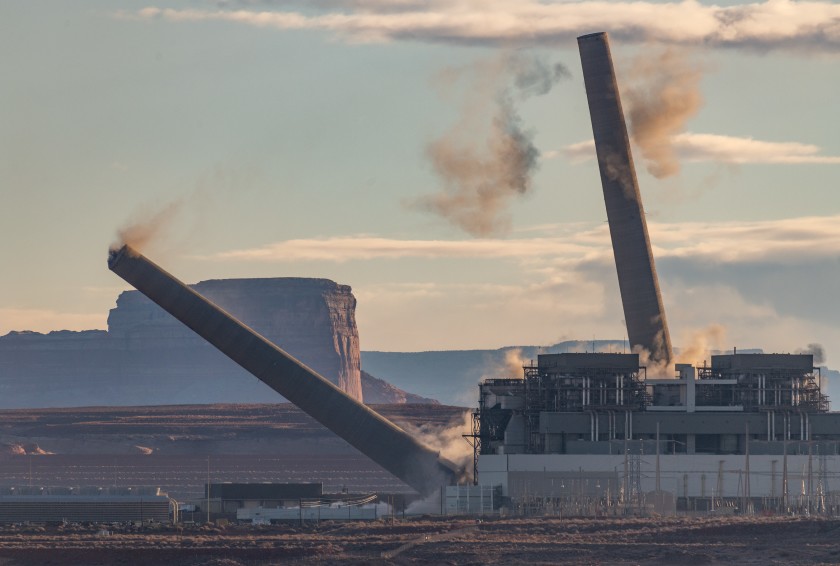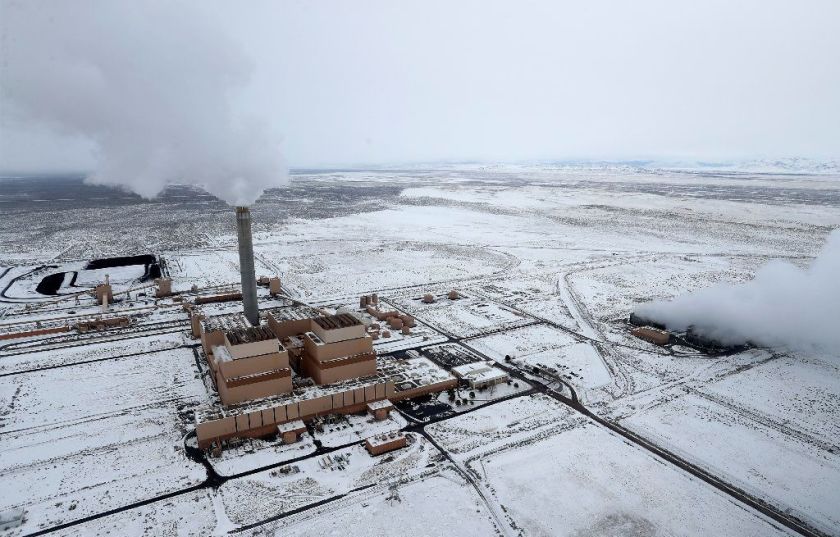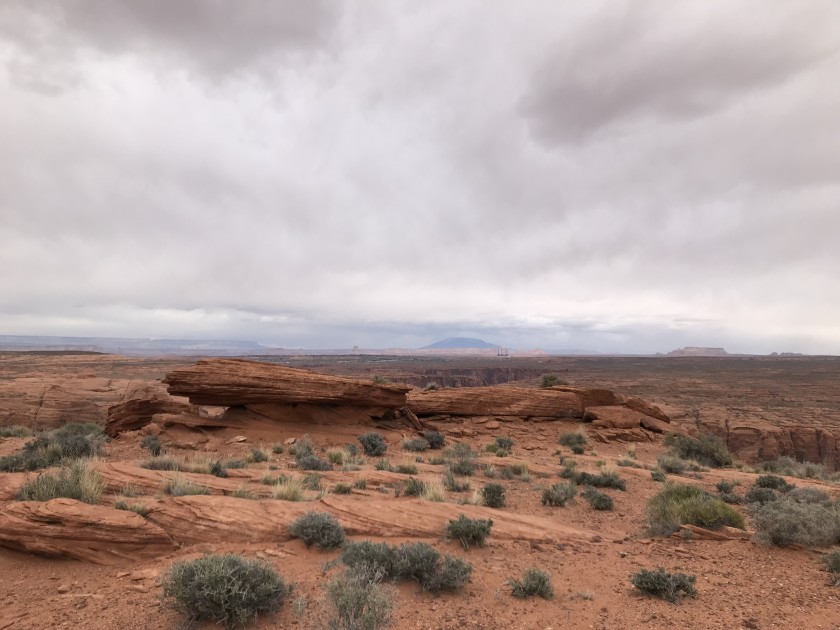
This is the Dec. 24, 2020, edition of Boiling Point, a weekly newsletter about climate change and the environment in California and the American West. Sign up here to get it in your inbox.
Navajo Generating Station, built half a century ago along the Colorado River near the Arizona-Utah state line, was the largest coal-fired power plant in the American West. It generated huge amounts of electricity for Los Angeles and powered the pumps that carry Colorado River water uphill to Phoenix, helping the desert city become a thriving metropolis. Its three 775-foot smokestacks towered over a gorgeous red rock landscape, belching planet-warming carbon dioxide and lung-damaging chemicals.
On Friday, demolition crews toppled the smokestacks with a series of thundering booms.
Here’s a video of the detonations that felled the once-might towers, courtesy of EcoFlight:
Navajo Generating Station stopped producing power last year, out-competed by cheaper electricity sources. The Arizona Republic’s Ryan Randazzo wrote about the smokestacks coming down, noting that the coal plant and associated mine once employed hundreds of workers, most of them Indigenous, while also fouling the air breathed by the Navajo and Hopi peoples.
“I’m relieved,” Hopi environmental activist Howard Dennis told Randazzo. “It’s been a struggle for a long time.”
The demolition capped off another tumultuous year for coal power. The industry helped build the modern West, but it’s collapsing as utility companies turn to natural gas, solar panels and wind turbines for lower-cost electricity, and as voters demand cleaner energy to reduce air pollution and confront the climate crisis.
After an eventful January that saw several western utilities pledge to move away from the dirtiest fossil fuel, I wrote that there were just 20 coal-fired generators left in the region without firm retirement dates. The list got shorter in June, when Colorado’s Platte River Power Authority pledged to shutter its Rawhide coal plant by 2030. Ten days later, the city of Colorado Springs decided to close one coal plant in 2023 and another by 2030.
New Mexico’s Escalante Generating Station produced its final coal-fired electrons in August, and Portland General Electric shut down Oregon’s last coal plant in October. Those facilities will be joined in retirement in the next few days by one of two units at Washington’s Centralia coal plant and one of four units at Arizona’s Cholla coal plant. PacifiCorp, a subsidiary of Warren Buffett’s Berkshire Hathaway empire, expects its Cholla unit to come offline around noon today, Christmas Eve.
Also in Arizona, officials approved new rules last month requiring utilities to achieve 100% carbon-free electricity by 2050. That spells trouble for the state’s two remaining coal plants without retirement dates, although coal supporters remain hopeful that carbon-capture technologies being tested in Wyoming might eventually offer the industry a lifeline.
There were also some fascinating developments at Utah’s Intermountain Power Plant, which is operated by the Los Angeles Department of Water and Power and generates about one-fifth of L.A.’s electricity — yes, from burning coal.

Intermountain is the last coal plant serving California, and it’s scheduled to shut down in 2025. I wrote last year about L.A.’s plan to replace the facility with a natural gas-fired plant that can eventually run on renewable hydrogen rather than gas — something that’s never been done before and isn’t guaranteed to work out.
Laura Nelson is hopeful. A former energy adviser to Utah Gov. Gary Herbert, Nelson was hired earlier this year to run the Green Hydrogen Coalition, a new nonprofit formed to support the Intermountain conversion and other initiatives. She sees the Intermountain site as a potential hub for a western hydrogen industry, in part because of the unique potential to store the clean fuel in naturally occurring underground salt caverns that happen to be located across the street from the coal plant.
In March, Intermountain Power Agency contracted with Mitsubishi Hitachi Power Systems to provide turbines that will initially run on a mixture of 30% hydrogen and 70% gas, with plans to ramp up to 100% hydrogen by 2045. Over the summer, the agency issued a request for proposals seeking companies that can produce hydrogen using renewable energy, most likely through a process known as electrolysis, in which water molecules are split into hydrogen and oxygen atoms.
It’s not just Los Angeles that stands to benefit. Arizona, Nevada, New Mexico and Washington have followed California’s lead in adopting 100% clean energy goals. In Utah, Salt Lake and 22 other cities and counties are targeting 100% clean energy by 2030. In Wyoming — home to a bunch of coal plants with no retirement dates — several cities are pushing to reduce emissions.
“We’ve come a long way in terms of how things are transitioning,” Nelson told me.
In Montana, the coal-burning Lewis and Clark station will make its final curtain call in March. Nevada’s major electric utility plans to close half of the state’s largest remaining coal plant next year; the other half could shut down as soon as 2022 following Idaho Power’s recent announcement that it hopes to exit the facility three years ahead of schedule. New Mexico’s San Juan Generating Station will shutter in 2022, with state regulators approving a plan this summer to replace its output with renewable power.
Even some of the western coal plants without firm retirement dates may not be long for this world.
Xcel Energy hasn’t set a deadline for closing three Colorado facilities, but the company has pledged to cut emissions 80% by 2030 and 100% by 2050, meaning a transition away from coal is almost certainly on the horizon. Then there’s the massive Colstrip plant in Montana. Its ability to operate past 2025 was recently thrown into question, when Puget Sound Energy’s agreement to sell part of its stake in the facility for $1 fell apart after Washington state regulators suggested they might reject the unusual deal.
Like I said, it’s been a tumultuous year for coal.
I never got a chance to visit Navajo Generating Station. But I did see it from a distance last year. While exploring Lees Ferry, the historic dividing point between the Colorado River’s upper and lower basins, I hiked to the top of a red rock plateau and looked north, spying the 775-foot smokestacks as tiny columns in the distance:

The demolition of those stacks can’t undo the decades of mercury, arsenic and sulfur dioxide they spewed into the air, or the carbon they launched into the atmosphere, which will remain there for centuries, heating the planet.
But this Christmas and every holiday season from now on, westerners will have a bit less coal in their stockings.